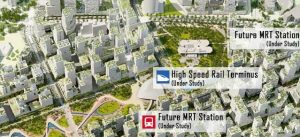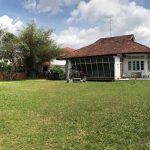Speaking to the media, the Malaysian Finance Minister said that the “Kuala Lumpur-Singapore high-speed rail can be “so much cheaper.” Minister Lim Guan Eng added that “if the financial architecture is done right, it doesn’t need to cost so much.
“If you work out the financial architecture, I think we can get it (Kuala Lumpur-Singapore high-speed rail project) so much cheaper. With the Bandar Malaysia land and all that…but I don’t want to reveal too much.” – Lim Guan Eng
These comments by Lim has raised expectations in some quarters that the shelved Kuala Lumpur-Singapore high-speed rail project may be revived sometime in the future.
Table of Contents

The news that the Malaysian Government has scrapped the Kuala Lumpur-Singapore high-speed rail project rocked the property market sentiments built around the Jurong Lake District area. Some experts suggested that the decision by the Malaysian Government could leave a ‘hole’ in Jurong Lake District area.
Lim said that the the Singapore Government agrees that given the economic climate, “what the Malaysian government is doing is necessary”, and added that the “the crux of the matter is that the cost is too high.”
In another interview, the Minister suggested that the Kuala Lumpur-Singapore high-speed rail project may be completed at “half the price”.
Lim’s assurance that the Kuala Lumpur-Singapore high-speed rail project can be revisited in the future, has now caused some to breathe a sigh of relief.
Writing in their Facebook, former MP Inderjit Singh and socio-economic commentator Dr Patrick Liew suggested that the decision to scrap the Kuala Lumpur-Singapore high-speed rail project was “based on both political and socio-economical factors.”
They argued that “from a political perspective, it will be hard-pressed for PM Mahathir and his administration to proceed with a project that was initiated by his political nemesis and allow him to claim any possible credit for positive outcomes.” and that “from a socio-economical perspective, the new administration has to grapple with the high debt that burdens Malaysia and objectively review not only the HSR project, but all other expenditure as well.”
Liew and Singh noted that “PM Mahathir did say that the HSR may be needed in the longer term and upgrading the current rail system to cut the travel time between KL and Singapore to 1.5 hours would suffice for now.” But they both acknowledged that “it is only right that the new Malaysia government review all major projects, especially those that involve huge investments that would strain the government’s budget.”
Singh and Liew suggested that if the cost of building the Kuala Lumpur-Singapore high-speed rail was a majr concern, the “HSR can be managed on a Build-Operate-Transfer basis…in other words, a major part of the costs can be borne by a credible and experienced operator from the private sector.”
This is what Singh an Liew said in full:
“Whither High Speed Rail Project?
Prime Minister Mahathir’s unofficial decision to scrap the High Speed Rail (HSR) project was based on both political and socio-economical factors.
The question is: is it a rational decision? Or, will the project be permanently called off?
From a political perspective, it will be hard-pressed for PM Mahathir and his administration to proceed with a project that was initiated by his political nemesis and allow him to claim any possible credit for positive outcomes.
From a socio-economical perspective, the new administration has to grapple with the high debt that burdens Malaysia and objectively review not only the HSR project, but all other expenditure as well.
The focus of the government will no doubt be to tackle the issues on the costs of living, growing the economy, creating jobs and showing that they are capable of bringing progress to Malaysia if they want to remain in power beyond the first term.
Having said that, it would be a pity if the HSR project were to be scrapped entirely.
PM Mahathir did say that the HSR may be needed in the longer term and upgrading the current rail system to cut the travel time between KL and Singapore to 1.5 hours would suffice for now.
Let’s break down the considerations objectively.
1. The costs that the HSR will incur are a major cause for concern.
Since this is the case, the HSR can be managed on a Build-Operate-Transfer (BOT) basis.
In other words, a major part of the costs can be borne by a credible and experienced operator from the private sector.
2. The HSR project will improve the lives and livelihoods of 13-15 million in Malaysia.
The improved connectivity will help to improve trade and commerce, synergy and leverage of talents as well as other resources, and bilateral relationships.
It will also provide more comfort, convenience and choices to commuters.
3. With the HSR, the bilateral relationships between Singapore and Malaysia will also be strengthened at different levels.
The improved infrastructure is estimated to reduce travel time by 1-1.5 hours compared to the fastest existing mode of travel.
This will bring about a revitalization of cities due to closer linkages with other places, increase in tourism and visitor spending, and economic usage of spaces around train stations.
Productivity will also improve due to possibility of working and meeting during travel, reduction in congestion, taking trips at the last minute, and no need for overnight stays.
There will be closer economic and cultural cohesion and integration due to cross border living and travel for business, pleasure, creation of businesses, jobs and services, improvement of infrastructure, and more value-added support and services.
In doing so, Singapore and Malaysia will form a stronger alliance to compete with their current and future competitors in the fast-changing global economy.
4. On top of these, the HSR project is estimated to create about 30,000 jobs.
This is before taking into account the many more jobs that would be created from the increased activities arising from the new infrastructure and convenience.
According to a report by Channel NewsAsia, “Apart from slashing travel time between Singapore and Kuala Lumpur, the rail link was expected to contribute RM21 billion (S$6.7 billion) in gross domestic product to Malaysia and Singapore, as well as create 111,000 jobs by 2060.
“Separately, an environmental impact assessment report in 2017 said that the long-term benefits for commuter safety and carbon emissions provided a “strong justification” for the project.”
https://www.channelnewsasia.com/…/kuala-lumpur-singapore-hs…
In our humble opinion, PM Mahathir is an astute politician and at his age, he would be more concerned about doing well for his country and leaving a positive legacy.
This should be the key focus of a leader – to improve the lives of his fellow countrymen.
The late Mr Lee Kuan Yew once called PM Mahathir a pragmatic leader who is relatively less concerned about racial, religious and other baggages.
If PM Mahathir is indeed the pragmatic leader we believe him to be, then we can expect him to make the right decisions.
To be fair, it is only right that the new Malaysia government review all major projects, especially those that involve huge investments that would strain the government’s budget.
It is their responsibility to prioritize the projects based on the country’s needs, goals of economic progress, and improving the lives of citizens.
The HSR will bring economic progress and benefit people of both countries – a win-win outcome and if we all believe this to be so, the outcome will be a positive one.
The model of the HSR as well as the terms and conditions of the agreement may need to be amended based on the assessment by the new Malaysian administration
Hopefully, they fit the political and socioeconomic factors mentioned earlier and if the outcome gives credit to the new administration and the people of Malaysia are happy with this outcome, we will all be better off.
Let’s give the new administration an opportunity to do what is right for their country.
A progressive Malaysia will be good for Singapore and the region.
If economic development is indeed a priority for the new administration, there would not be a better friend than Singapore and Singaporeans.
Singaporeans, Singapore companies, and the Singapore government are in the best positions to help contribute to the economic development and betterment of Malaysia, not just through the HSR project, but also in many other areas that would bring about mutual benefits.
I hope that the 4G leaders will be sensitive to the thoughts and feelings of the Malaysian leaders and their people.
We should stand with them during this challenging period as a true friend in need and extend our best possible assistance to them.
It is important that the people on both sides of the causeway maintain their cool and not overreact to any changes.
Each and every one of us should do our part to improve bilateral relations and contribute to mutual progress and prosperity.
We want Malaysia to succeed. Mahathir wants Malaysia to succeed.
If the HSR project is in the best interest of both countries, at the right time, we will surely see the project restarted.
For now, let’s work towards a win-win future with our brothers and sisters on the other side of the causeway.”
But what’s driving the interest in the Jurong Lake District area is not just the Kuala Lumpur-Singapore high-speed rail project, but the successful transformation resulting from the Jurong Gateway initiative. The project (if it takes off) will only be a nice bonus to the buyers of property in that area.
If you are home-hunting in the Jurong Lake District area, our Panel of Property agents and the mortgage consultants at icompareloan.com can help you with affordability assessment and a promotional home loan. The services of our mortgage loan experts are free. Our analysis will give best home loan seekers better ease of mind on interest rate volatility and repayments.
Just email our chief mortgage consultant, Paul Ho, with your name, email and phone number at paul@icompareloan.com for a free assessment.






